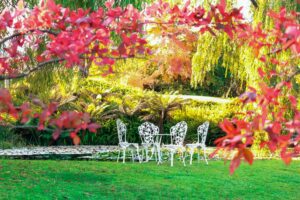In order to ensure that the furniture you choose for your garden not only looks good but also serves your functional needs and endures outdoor elements, several factors must be taken into account. Here are some guidelines to follow when selecting outdoor furniture:
Determine Your Budget:
Establishing a budget for your outdoor furniture is the first step. This will enable you to reduce your options and avoid spending too much money.
Assess Your Space:
Measure your outdoor space to determine how much room you have available for furniture. Consider the layout and the placement of the furniture to ensure it fits comfortably.
Define Your Purpose:
Consider the intended use of your garden area. Which do you prefer—dining, relaxing, or both? Your furniture selection will be influenced by understanding your main purpose.
Consider Material:
There are many materials available for garden furniture, and each has benefits and drawbacks.
Wood:
Traditional and organic, but maintenance is needed to stop rot and decay.
Metal (e.g., aluminum, wrought iron):
durable and low-maintenance, but could become warm in direct sunlight.
Plastic or Resin:
Though possibly less durable than other materials, it is inexpensive and simple to clean.
Wicker or Rattan:
Thoughtful and cozy, it might need some maintenance now and then.
Teak:
Naturally weatherproof high-quality wood, though it can be pricey.
Weather Resistance:
Make sure the furniture you select is made to withstand the weather where you live. Look for qualities like water-resistant cushions, rust- and UV-resistant metal.
Comfort and Style:
Useful outdoor furniture should be cozy. Verify that the backs and seats offer sufficient support by testing them. Additionally, select a design that enhances the overall aesthetic of your garden.
Storage Options:
Consider furniture that can be folded or disassembled easily for storage if you have a small storage area or intend to store it during the off-season.
Maintenance:
Regarding how much upkeep you are willing to perform, be realistic. While some materials essentially do not need any maintenance, others do need routine cleaning, sealing, or staining.
Cushions and Fabrics:
Verify the removable, machine-washable covers on any cushions that come with your furniture. Choose fading- and mildew-resistant fabrics with outdoor ratings.
Eco-Friendly Options:
If sustainability is important to you, look into eco-friendly options like recycled plastic or reclaimed wood furniture.
Test Before You Buy:
When buying furniture, try it out in-person whenever possible. Sit in the chairs, examine the stability of the tables, and evaluate the level of comfort.
Read Reviews and Recommendations:
Ask friends and family who own outdoor furniture for recommendations and read online reviews. They can offer insightful commentary and helpful suggestions.
Warranty and Return Policy:
The furniture you are considering should have a warranty and a return policy. In the event of unforeseen problems, this may help you feel at ease.
Accessories:
To improve the usability and ambiance of your garden space, do not forget about accessories like umbrellas, outdoor rugs, and lighting.
You can select outdoor furniture that meets your needs, enhances your outdoor area, and lasts for many years by taking into account these factors.
The photo is from unsplash.com



